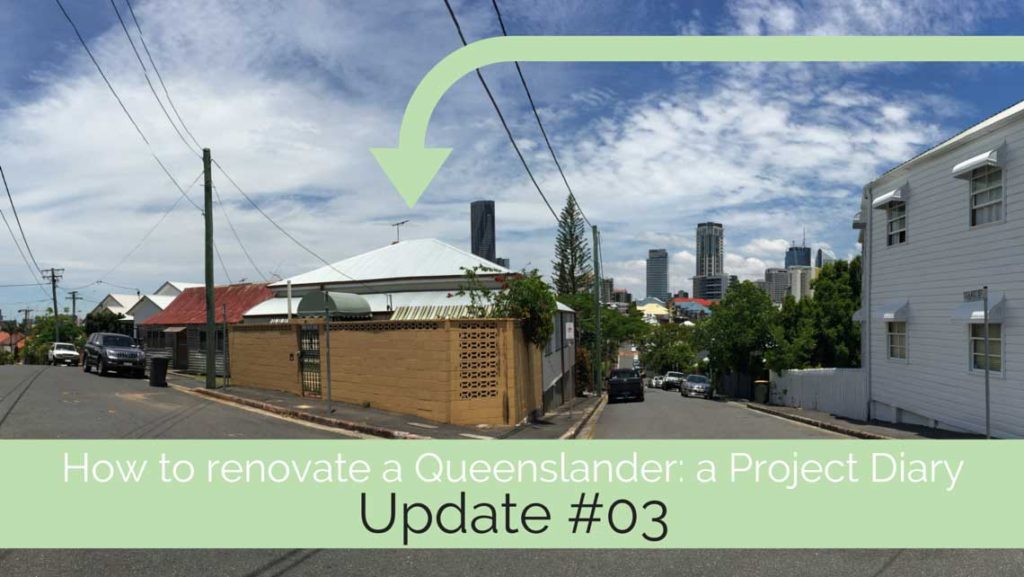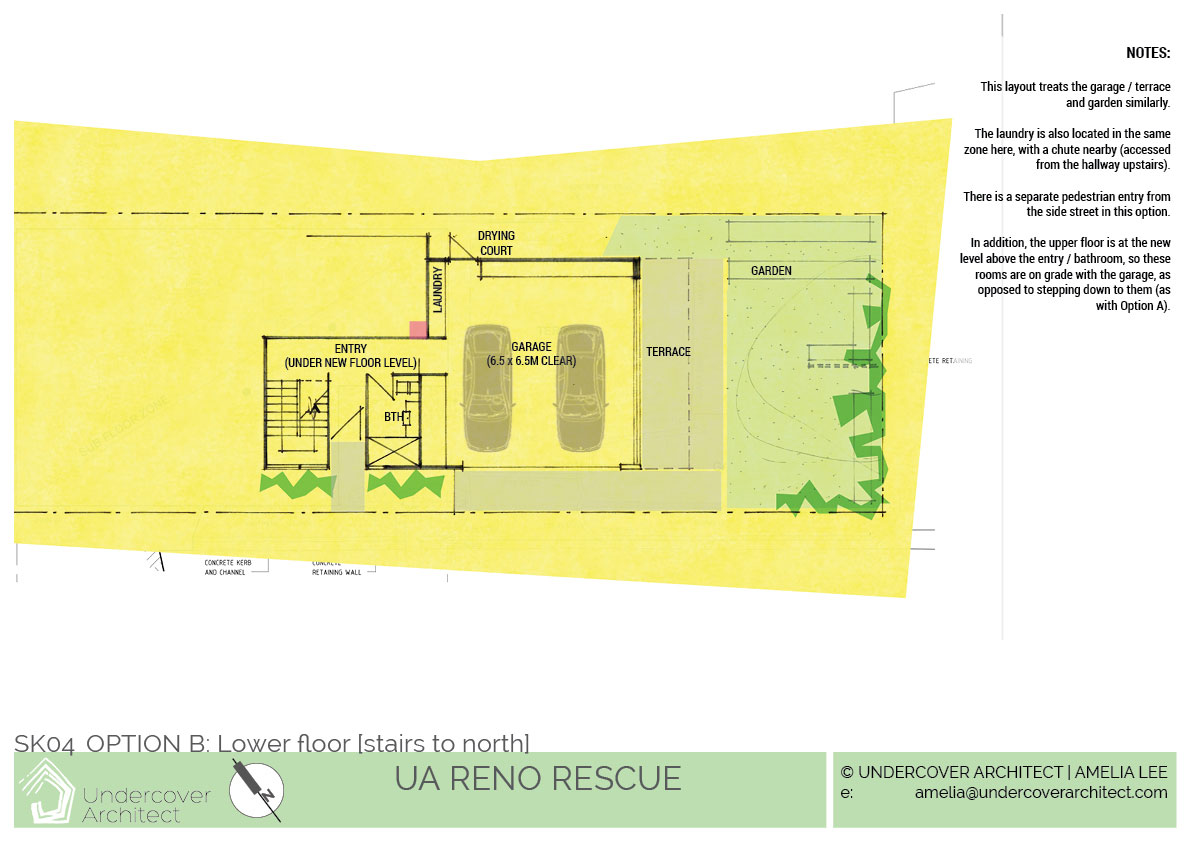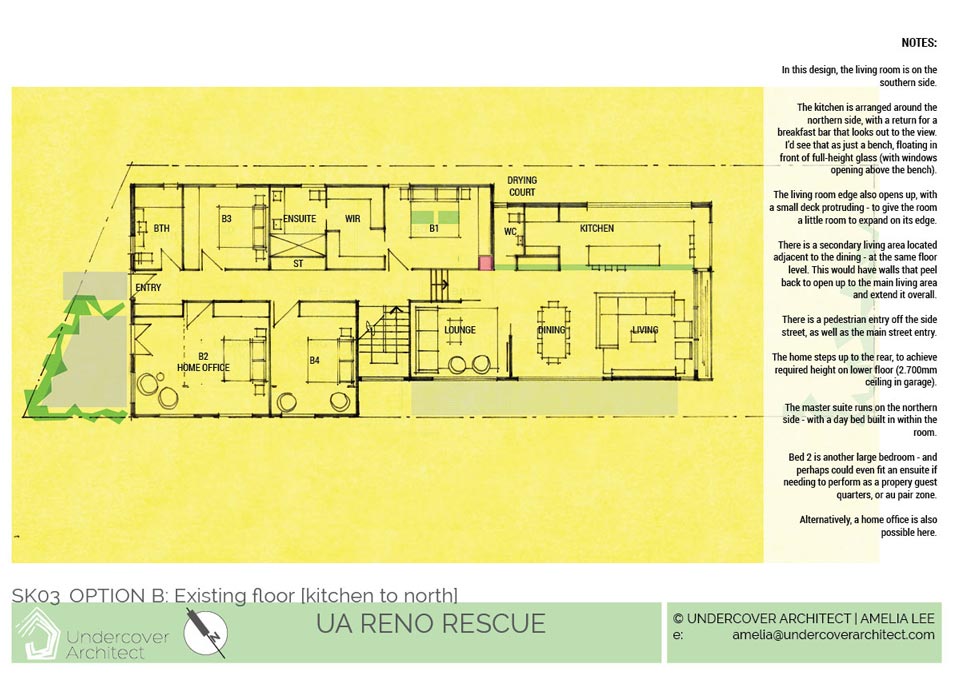
In our last project diary instalment of renovating a Queenslander cottage, I took you through Michelle and Sarah’s Reno Roadmap package, and the 2 options that were designed as a result. In this latest update, Michelle and Sarah choose an option, and the project hits an unexpected speed bump before moving forward!
After being presented with the 2 design options, Michelle and Sarah then spent some time reviewing them to see their personal preferences. I also recommended to them that, given they were renovating this home to sell in the near future, they seek advice from local real estate agents as well.
So which option did they choose? (Drumroll please ….)
They chose Option B. Here it is again:


The reasons they preferred Option B?
The main feedback was that:
- the arrangement of the living / dining room enabled the view to be on full display when walking into that space
- the second bedroom with its own retreat area (and in close proximity to the main bathroom) was seen as an asset for a live-in nanny, or guests
- they liked the secondary living area being in close proximity to the main living area and kitchen
So what happens next?
Michelle and Sarah were keen to move onto the next stage of renovating, and progress these designs further.
I had done preliminary planning investigations as part of preparing the two options, as mentioned in our last instalment.
To progress further, I forwarded the preferred option to a selection of planning consultants I work with, to get their professional advice.
Each gave a slightly different opinion … which as an industry professional is always interesting. (And I suspect, as a non-industry professional, would be totally infuriating!)
The initial intention was (as I’ve done with several other projects involving this type of renovation / extension to a pre-1946 home, including my own in Ashgrove), to seek approval via the RiskSMART process.
RiskSMART is Brisbane City Council’s (BCC) fast track development approval process. External planning consultants are accredited by BCC to assess planning applications where the proposed work doesn’t fit the definition of ‘self-assessable’ but is fully compliant with the local plan.
One planner, however, actually sought some direct advice from the RiskSMART team planners within the team at Brisbane City Council (BCC).
BCC threw up this red flag …
“… the proposed extensions are not considered suitable for RiskSMART due to the fact the building is highly likely to be pre-1911 meaning that all demolition is a performance based outcome.
Please be aware that Council’s architect has not definitively confirmed the date of the building but based this conclusion on the style/features shown. In terms of dating the building I have been advised that it will be up to the applicant to determine the date.
Your options are either to assume it is pre-1911 and address the demolition code accordingly or to seek postal records for the property. I am told these records are available at Council libraries.”
Righteo.
What’s this about 1911? And why is it so important?
The current Brisbane City Plan that development is approved under is the “Brisbane City Plan 2014”. It formally commenced on June 30, 2014, after a long (long) period of public consultation. It replaced the Brisbane City Plan 2000. (You can learn more about the project background here).
The previous City Plan 2000 protected homes that were pre-1900, and had a formal list of these properties.
It also had identified Demolition Control Precincts (or DCPs) which largely focused on older suburbs of Brisbane with a significant portion of “Character Homes”. As mentioned in the last instalment, the first time an aerial photograph was taken of Brisbane was 1946. So, pre-1946 homes are also protected in DCPs, and require specific tactics and approvals when proposing a renovation.
There were – and still are – rules to satisfy if you wish to demolish anything in a pre-1946 building. And there’s still Demolition Control Precincts (however, now they’re referred to as “Neighbourhood Character” areas. (This is a great article about the changes if you want to know more).
The new City Plan 2014 changed the date of 1900 to 1911, for homes that had an extra layer of protection, and added more homes to the list.
In a document dated January, 2013, Council answered why the date was being changed from 1900 to 1911:
Council is committed to preserving Brisbane’s heritage and character. Acting on feedback from residents seeking greater protection for pre-Federation housing styles within Brisbane, Council conducted a citywide survey to identify unprotected examples of these rare architectural typologies. This resulted in the identification of the houses contained in the list.
The survey revealed that a number of houses built after 1900 (post-Federation) displayed architectural characteristics which were representative of these pre-Federation houses. In addition, historic records which are used to identify the dates of construction of these early housing styles become more accurate in the immediate period following federation. [Source is here]
Phew, my home isn’t on the 1911 map
In the preliminary due diligence for the Reno Rescue package, I established that Michelle and Sarah’s home wasn’t on the 1911 mapping. It was however, definitely pre-1946, so the proposed renovation and extension designs took this into account, and retained the bulk of the existing building. Minor demolition was proposed for the rear verandah spaces in order to connect the new extension into the existing home.
However, once BCC speculated that the home may in fact be pre-1911, RiskSMART was no longer available to us as an option.
Even though the home wasn’t on the 1911 maps, BCC made it clear that it was the owner’s responsibility to establish that the home wasn’t pre-1911 – otherwise the application would need to meet pre-1911 rules regardless. We either found out for certain (with the hope the rear verandahs were a later addition), or adjusted the design now.
The hunt begins
What needed to be determined was:
- is the home pre-1911? and;
- if it is, how much of it is pre-1911, and how much was added later?
The town planner recommended that research begin at the Brisbane City Council Library, in Brisbane’s CBD.
The owners also started by speaking to neighbours who had lived in the area for a long time. And a heritage architect’s assessment was recommended to establish the age of the home.
In an ideal world, we were hoping that if the home was discovered to be pre-1911, that the verandahs were built later, and not protected by the same planning rules – as the rear verandahs were the only items impacted by the proposed design.
Below is a summary of what the owners discovered in their hunt:
- They obtained 4 historic title documents dating back as far as 1874 when it was part of a 4-piece block of land. The first title document they obtained dates the split of lot 1 (their property) on 16th May 1874.
- The first Bill of Mortgage on the property was 18 December 1874.
- Surveyor field notes from 1 September 1913 through to 17th July 1944, which also indicate no further building work was performed in this period.
- Interesting but not relevant was a number of unusual residents (based on postal directory and including a dentist) that were not the owners between the late 1800’s through to about 1910 … The house was owned by a butcher from Toowoomba for most of this time.
- They spoke to BCC and, with them, reviewed building records and there was no concrete evidence of any building records for the address between 1911 and 1946 – making council believe the verandahs are most likely are pre 1911.
- There are 2 building cards for 1961 which are hard to read and really don’t reveal much of what was done. One is for an area 18 feet by 12 feet which they believed is most likely the garage at the back of the property. The other says repairs, lights and is quite vague.
- In summary they have not found any record, be it a photo or a building record, to indicate anything significant has been done to the property post 1911.
What does this all mean?
It means we are dealing with a home that is most likely to be ALL pre-1911 (except for the ramshackle deck added to the rear, and the garage in the back garden).
And it meant that, if we wanted to take a simple approval route, which was likely to achieve town planning approval, we needed to adjust the design to preserve the existing home to its full extent. Given the desire to get approval quickly, and keep moving with program, we needed to create a proposal that was compliant with the town plan.
The owner also had a heritage architect visit the home – and he basically confirmed the owner’s research. Again, it was hoped that once the actual structural timbers were inspected, we may be able to ascertain a difference between the verandah timbers and those of the home. This was not the case, however.
So where to now?
Having established, unequivocally, that the home is pre-1911 (despite the fact is wasn’t listed on council’s mapping), the next stage of this project involved tweaking the design to retain the existing verandahs. But that’s for the next instalment.
Do you know the history of your home?
What was, I think, an interesting byproduct of this exercise, was that all of us involved in the project, got to know the home’s history so much better.
It helped us all realise that this building had a rich history which was something to be honoured and respected in how we moved forward with the renovation. And that sharing that story with future owners of the home would help celebrate its history too.
If you have an old home in Queensland, and want to know more about its history, these are a couple of sites that may help.
It has searchable archives of newspapers etc that may help.
http://www.househistories.org/
I follow a woman on Instagram (@westendcottage) – and they’ve relocated an old home from West End to the Byron Hinterland. She’s been researching the history of it, and sharing some findings. She said that street numbers were gradually rolled out across Brisbane’s suburbs from 1905 to 1940, and in their absence, addresses were often identified as house names. So their new home was once known as “Northland Villa”. She suggested typing the name of the house, or the name of the former owners / occupants into Trove to see what it brings up.
Next time
I’ll take you through how we adjusted the design to enable us to keep all of the 1911 home, and the strategy we created to ensure these hiccups wouldn’t prevent us meeting program.
Other blogs you may find useful …
We didn’t want to push council rules because we wanted as speedy an approval as possible – but perhaps you have time up your sleeve and want to push the rules?
Why aren’t we raising and restumping the old girl? Well, this is where money can disappear in a reno.
We couldn’t demolish this home – but perhaps you’re able to knock down yours. Here’s how to decide whether to renovate or detonate.
 With over 30 years industry experience, Amelia Lee founded Undercover Architect in 2014 as an award-winning online resource to help and teach you how to get it right when designing, building or renovating your home. You are the key to unlocking what’s possible for your home. Undercover Architect is your secret ally
With over 30 years industry experience, Amelia Lee founded Undercover Architect in 2014 as an award-winning online resource to help and teach you how to get it right when designing, building or renovating your home. You are the key to unlocking what’s possible for your home. Undercover Architect is your secret ally
Leave a Reply